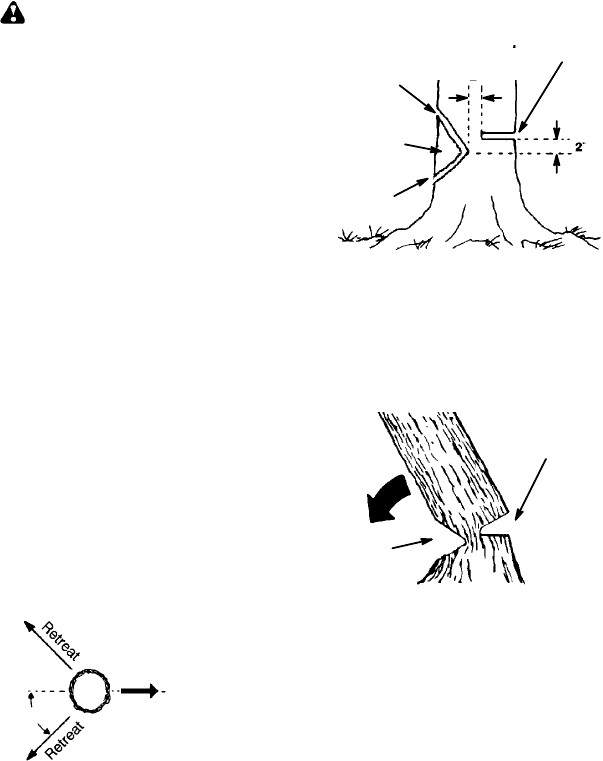
12
S Release the throttle trigger as soon as
the cut is completed, allowing the en-
gine to idle. If you run the saw at full
throttlewithoutacuttingload,unneces-
sary wear can occur to the chain, bar,
and engine.
S Toavoidlosingcontrolwhencutiscom-
plete,d onotputpressureonsawatend
of cut.
S Stop the engine before setting the saw
down after cutting.
TREE FELLING TECHNIQUES
WARNING: Check for broken or
dead branches which can fall while cutting
causingserious injur y. Donotcutnearbuild-
ingsor electricalwiresifyoudonotknowthe
directionoftreefall,norcutatnightsinceyou
will not be ale to see well, nor during bad
weathersuchasrain, snow,orstrongwinds,
etc. Ifthetree makes contactwith an yutility
line, the utility company should be notified
immediately .
S Carefullyplanyoursawingoperationinad-
vance.
S Cleartheworkarea. Youneedacleararea
allaroundthetreesoyoucanhavesecure
footing.
S Study the natural conditions that can
cause the tree to fall in a particular direc-
tion.
Natural conditions that can cause a tree to
fall in a particular direction include:
S The wind direction and speed.
S The lean of the tree. The lean of a tree
might not be apparent due to uneven or
slopingterrain. Useaplum borleveltode-
termine the direction of tree lean.
S Weight and branches on one side.
S Surrounding trees and obstacles.
Look for decay and rot. If thetrunk isrotted,
it can snap and fall toward the operator.
Check for broken or dead branches which
can fall on you while cutting.
Make sure there is enough roomfor thetreeto
fall. Maintain a distance of
2-1/2 tree length s
from the nearest person or other objects. En-
gine noise can drown out a warning call.
Remove dirt, stones, loose bark, nails, sta-
ples,andwirefromthetreewherecutsareto
be made.
Planaclearretreat pat hto therearanddiag-
onal to the line of fall.
Direction of Fall
45_
Plan a clear retreatpath
FELLING LARGE TREES (6 inches
(15 cm) in diameter or larger)
The notch methodis used to f elllarge trees.
Anotchiscutonthesideofthetreeinthede-
sired direction of fall. After a felling cut is
made on the opposite side of tree, the tree
will tend to fall into the notch.
NOTE: If the tree has large buttress roots,
removethembeforemakingthenotch. Ifus-
ing saw toremove buttress roots, keep saw
chainfromcontactinggroundtopreventdull-
ing of the chain.
NOTCH CUT AND FELLING THE
TREE
S Make notch cut by cutting the top of the
notch first. Cut through
1/3 ofthediameter
ofthetree.Nextcompletethenotchbycut-
ting the bottom of the notch. See illustra-
tion. Once the notch is cut, remove the
notch of wood from the tree.
Notch
First cut
Second cut
Final cut here. 2inches above
center of notch.
S After removing the wood from the notch,
makethefellingcutontheopposite sideof
the notch. This is done by making a cut
abouttwo i n ches higherthan thecenterof
the notch. This will leave enough uncut
woodbetweenthefellingcutandthenotch
toformahinge.Thishingewillhelpprevent
the treefromfalling inthewrongdirection.
Opening
of felling
cut
Closing of
notch
Hinge holds tree on stump and helps
control fall
NOTE: Before felling cut is complete, use
wedges to open the cut when necessary to
controlthedirectionoffall. Toavoidkickback
and chain damage, use wood or plastic
wedges, but never steel or iron wedges.
S Bealerttosignsthatthetreeisreadytofall:
cracking sounds, widening of the felling cut,
or movement in the upper branches.
S As treestarts to fall,stop saw ,put itdown,
and get away quickly on your planned re-
treat path.
S DO NOT cut down a partially fallen tree
withyour saw. Beextremely cautiouswith
partially fallen trees that may be poorly
supported. When a tree doesn’t fall com-
pletely,setthesawasideandpulldownthe
tree with a cable winch, block and tackle,
or tractor.


















